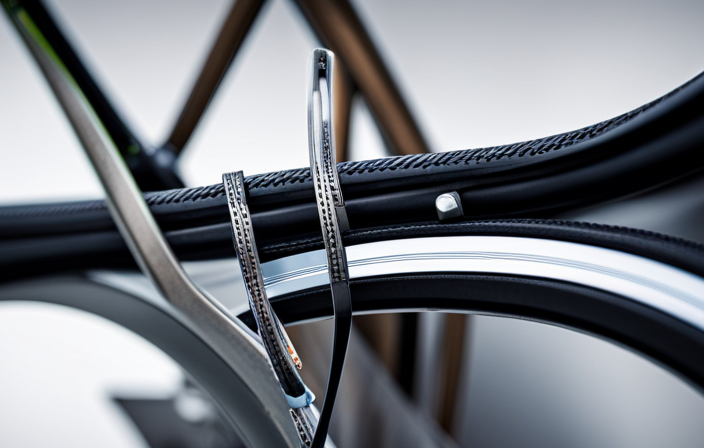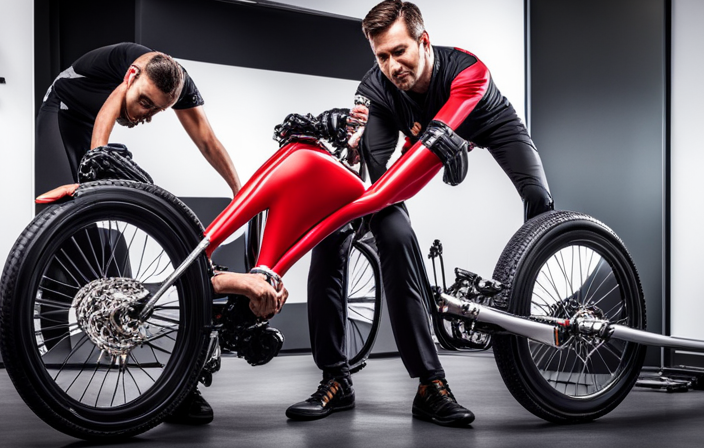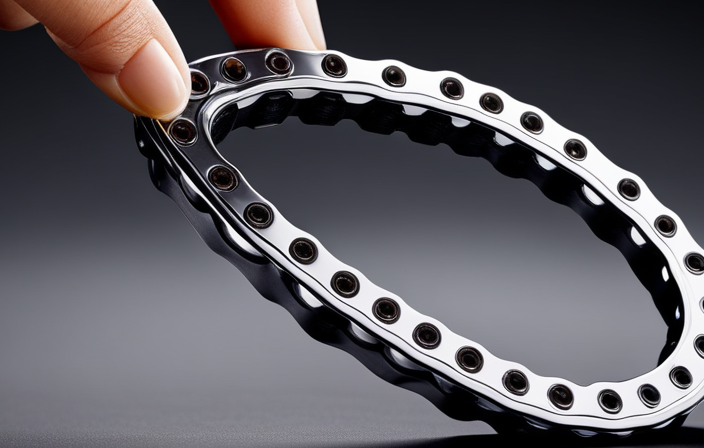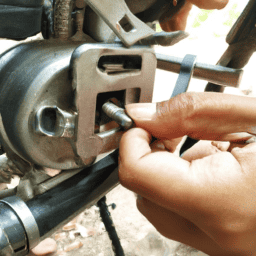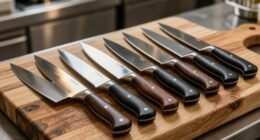Imagine you are on an exhilarating bike ride, feeling the wind in your hair, when all of a sudden, you hear that dreaded hiss. Your tire is flat, and you need a replacement bicycle tube.
But how do you find the right size? Fear not, fellow cyclists, for I am here to guide you through this perplexing quest. In this article, I will provide you with the knowledge and steps necessary to determine the exact bicycle tube size you need, ensuring a smooth and enjoyable ride every time.
Let’s dive in!
Key Takeaways
- Check tire sidewall for diameter and width
- Ensure valve type matches tube
- Consider recommended tire pressure
- Prevent flat tires by ensuring compatibility
Understand the Basics of Bicycle Tubes
To find the correct bicycle tube size, you’ll need to understand the basics of bicycle tubes. Proper tube sizing is crucial for optimal bike performance. Choosing the wrong size can lead to issues like frequent punctures, poor handling, and increased rolling resistance.
One common mistake is using a tube that is too narrow or too wide for the tire. This can cause the tube to stretch or fold inside the tire, leading to premature failure. Another mistake is not considering the valve type. There are two common valve types: Presta and Schrader. Using the wrong valve type can result in a tube that doesn’t fit properly in the rim hole.
Now that you understand the importance of tube sizing, let’s move on to determining the wheel size of your bike.
Determine the Wheel Size of Your Bike
To determine the wheel size of my bike, I first measure the diameter of the wheel using a tape measure. This measurement is typically in inches and is taken from the center of the wheel to the outer edge.
Additionally, I check the tire sidewall for information on the wheel size. The tire sidewall usually has a series of numbers and letters that indicate the wheel size, including the diameter and width.
By following these steps, I can accurately determine the wheel size of my bike.
Measure the Diameter of the Wheel
First, you’ll need to measure the diameter of your wheel. To measure the wheel diameter accurately, follow these steps:
- Position the bike upright and make sure the wheel is fully inflated.
- Place a ruler or measuring tape against the top edge of the wheel rim.
- Measure from one side of the rim to the exact opposite side, passing through the center of the wheel.
When measuring the diameter, it’s important to avoid common mistakes such as measuring the tire instead of the wheel rim or not measuring through the center. These errors can lead to inaccurate measurements and make it difficult to find the correct bicycle tube size.
Now that you have the wheel diameter, let’s move on to the next step and check the tire sidewall for information.
Check the Tire Sidewall for Information
Next, take a look at the tire sidewall for relevant information. Checking the tire sidewall is crucial in finding the right bicycle tube size. This is where you can find valuable details about the tire, including its width.
Look for a series of numbers separated by slashes or dashes. One of these numbers represents the tire’s width. It is important to measure the width accurately, as even a small discrepancy can affect the tube’s fit. Use a ruler or calipers to measure the width from one side of the tire to the other.
Once you have the accurate measurement, you can move on to identifying the width range for your tire, which will help you in selecting the correct bicycle tube size.
Identify the Width Range for Your Tire
Check the sidewall of your tire for the width measurement. The width of a bicycle tire is typically indicated by a series of numbers and letters, such as "700x25c" or "26×1.95". The first number in this sequence represents the diameter of the tire, while the second number denotes the width. To find the correct tube size, you need to identify the width range for your tire. It’s important to note that tire widths can vary, and there are a range of measuring techniques you can use to determine the width accurately. Common tire widths include 23mm, 25mm, 28mm, and 32mm. By knowing your tire’s width, you can then move on to consider the valve type. This will ensure you choose the correct tube for your bicycle.
Consider the Valve Type
To determine the correct valve type for your tire, take note of the valve stem on your tire. There are three main types of valve stems: Schrader, Presta, and Woods.
Schrader valves are the most common and can be found on most standard bicycle tires. They are easy to use and can be inflated using a regular air pump.
Presta valves, on the other hand, are thinner and require a special pump with a smaller attachment. They are commonly found on high-performance bikes and are known for their ability to hold higher pressures.
Woods valves, also known as Dunlop valves, are less common but can still be found on some older bikes. They have a similar design to Presta valves but are wider and can be inflated with a regular pump.
When it comes to maintaining and caring for bicycle valves, make sure to regularly check for any leaks or damage, and keep them clean and lubricated.
Now, let’s move on to determining the tube size.
Determine the Tube Size
To determine the tube size for your bicycle, there are a couple of key points to consider.
First, you can use a tube sizing chart which provides specific measurements for different tire sizes. This will ensure that you select the correct tube size for your bike.
Additionally, it is always helpful to consult with a bike shop expert who can provide guidance and advice based on your specific bike model and tire size. Their expertise will ensure that you choose the right tube size for optimal performance and safety.
Use a Tube Sizing Chart
Using a tube sizing chart is a helpful way to find the correct bicycle tube size. Tube size conversion can be confusing, as there are different measurements used for tube sizes.
Common tube sizes include 26-inch, 27.5-inch, and 29-inch for mountain bikes, and 700c for road bikes. To use a tube sizing chart, start by measuring the diameter of your tire. Then, match the diameter measurement with the corresponding tube size on the chart.
It’s important to note that tube sizing charts may vary slightly between manufacturers, so it’s a good idea to consult with a bike shop expert for confirmation. They can provide additional guidance and ensure you get the right size tube for your bike.
Consult with a Bike Shop Expert
If you’re unsure about the correct tube for your bike, it’s best to consult with a bike shop expert. They have the knowledge and experience to help you find the right size tube for your specific bike model.
Here are some bike shop recommendations to consider when seeking their expertise:
- Visit a local bike shop with knowledgeable staff who can provide personalized advice.
- Ask for recommendations based on your bike’s tire size and type.
- Don’t rely solely on online guides or forums, as they may not account for specific bike variations.
- Be open to trying different tube brands and materials to find the best fit for your riding style.
- Don’t fall for common misconceptions, such as assuming that all tubes of the same tire size will fit your bike.
By consulting with a bike shop expert, you can ensure that you choose the correct tube size for your bike.
Now, let’s move on to the next section about choosing the tube material.
Choose the Tube Material
When choosing the tube material, you’ll want to consider factors such as durability and weight. Tube durability is important because you want a tube that can withstand the bumps and rough terrain without easily puncturing. Look for tubes made from materials like butyl rubber, as they are known for their durability.
On the other hand, tube weight is also a crucial factor to consider, especially if you’re looking for a lightweight bike setup. Opt for tubes made from lighter materials like latex or synthetic rubber, as they can reduce the overall weight of your bike. Additionally, lighter tubes can provide a more responsive ride.
Once you’ve chosen the tube material, the next step is to check for compatibility with your tire type.
Check for Compatibility with Your Tire Type
To ensure a proper fit, it’s important to check if the tube is compatible with your tire type. This step is crucial because using the wrong tube can lead to problems such as flat tires or even accidents. To determine compatibility, you need to consider factors such as tire size, valve type, and tube width. Refer to the tire sidewall for information on tire size, including diameter and width. Valve type can be either Presta or Schrader, so make sure the tube has the corresponding valve. Additionally, check the recommended tire pressure as it varies depending on the tire type. By ensuring compatibility, you can prevent common causes of flat tires and ride with confidence. With this knowledge, you can now proceed to the next section and purchase the correct tube size seamlessly.
Purchase the Correct Tube Size
After checking for compatibility with your tire type, it’s time to purchase the correct tube size. This step is crucial to ensure a proper fit and prevent any issues while riding.
There are various options available for purchasing bicycle tubes, both online and in physical stores. Online resources such as cycling websites and online retailers provide a wide range of tube sizes to choose from. When purchasing online, make sure to carefully read the product descriptions and reviews to ensure you are getting the right size.
Additionally, consider checking with your local bike shop for their recommendations and availability.
Once you have purchased the correct tube size, you can move on to the next step of removing the old tube, which is an important part of the process to ensure a successful tube replacement.
Remove the Old Tube
Before removing the old tube, it’s important to ensure the bike is in a stable position. This will prevent any accidents or damage while working on it. Once the bike is secure, it’s time to remove the old tube. Start by deflating the tire completely and then use a tire lever to carefully pry the tire off the rim. Be cautious not to damage the rim or tire in the process. Once the tire is off, gently remove the old tube from inside. Now, you can proceed to install the new tube. When choosing the right tube, consider factors like the type of bike and the terrain you will be riding on. Additionally, installing a puncture-resistant tube can help prevent future flats. With the old tube removed, it’s time to move on to the next step of installing the new tube.
| Column 1 | Column 2 | Column 3 |
|---|---|---|
| Inflate the tire slightly to give it shape. | Check the tire for any sharp objects or debris. | Insert the valve of the new tube into the valve hole of the rim. |
Remember to take your time and be precise during this process to ensure a successful tube replacement. Now, let’s move on to the next section and learn how to install the new tube properly.
Install the New Tube
Now, it’s time to put in the new tube and get your bike ready for riding again!
Start by installing accessories such as reflectors or valve caps onto the new tube.
Make sure the tube is properly aligned with the tire, matching the valve hole with the valve stem.
Carefully insert the valve stem into the valve hole and push the tube into the tire, making sure it sits evenly inside.
Check for any twists or folds in the tube before proceeding.
Once the tube is in place, troubleshoot common issues like pinching or snagging by gently pushing the tire onto the rim, ensuring it fits snugly.
Now, you can transition into the subsequent section about inflating the tube to the proper pressure and getting ready to hit the road again.
Inflate the Tube to the Proper Pressure
After successfully installing the new tube, it is crucial to inflate it to the proper pressure to ensure a smooth and safe ride. Proper inflation is essential for optimal performance and longevity of your bicycle tube. When inflating, it is important to follow the manufacturer’s recommendations for the specific tube size you have. Overinflating can lead to tube damage or even blowouts, while underinflating can cause pinch flats or an uncomfortable ride. To help you with the proper inflation, I have prepared a table below that lists the recommended pressure ranges for different tire sizes. Additionally, I will discuss some common inflation issues and troubleshooting tips. Once you have inflated the tube to the correct pressure, it’s time to move on to the next step – checking for leaks.
Check for Leaks
To check for leaks, you’ll need to inflate the tube to the proper pressure and then submerge it in water. This method is effective in identifying any punctures or holes in the tube.
Start by inflating the tube to the recommended pressure, which is usually indicated on the sidewall of the tire. Once inflated, carefully place the tube in a container filled with water, ensuring that it is completely submerged. Slowly rotate and flex the tube, paying close attention to any bubbles that may appear. These bubbles indicate the presence of a leak.
Once you’ve identified the puncture, you can patch the bicycle tube using a patch kit. This process involves cleaning the area around the puncture, applying adhesive, and affixing the patch.
With the tube repaired, you can now move on to the next step in preparing your bike for a test ride.
Test Ride Your Bike
After checking for leaks in your bicycle tube, it’s time to take your bike for a test ride. This step is crucial in determining the correct tube size for your bike.
When you ride your bike, pay attention to how it feels and fits. Is the bike too small or too big for you? Are you comfortable while riding? These factors are important because finding the right tube size is not just about preventing flats, but also about ensuring a proper bike fit.
During the test ride, you can also assess the overall performance of your bike, making note of any adjustments or maintenance that may be needed.
Once you have completed the test ride, you can move on to the next section on how to maintain your bicycle tubes.
Maintain Your Bicycle Tubes
Make sure you regularly check the air pressure in your bike tires to maintain the performance of your bicycle tubes. Proper bike tube maintenance is crucial for a smooth and safe ride.
One common tube problem is punctures. Inspect your tubes regularly for any sharp objects stuck in them, such as nails or glass, and remove them immediately.
Another common issue is pinch flats, which occur when the tube gets pinched between the tire and rim during impact. To prevent this, make sure your tires are properly inflated and avoid hitting obstacles at high speeds.
It’s also important to keep your tubes clean and dry, as moisture can cause corrosion or damage. Additionally, consider using tire liners or sealants to provide extra protection against punctures.
By taking these steps, you can ensure that your bicycle tubes stay in optimal condition for a longer period of time.
Frequently Asked Questions
Can I use a tube with a different valve type than my tire?
No, it is not recommended to use a tube with a different valve type than your tire. Tube compatibility is important for proper inflation and functionality. Different valve types have their advantages, so it’s best to match them for optimal performance.
How often should I check my tube for leaks?
I recommend checking your bicycle tube for leaks every few weeks, especially if you ride frequently. To patch a bicycle tube, first locate the leak, clean the area, apply the patch, and ensure a secure bond. As for replacement, it depends on usage and wear.
What’s the difference between a Presta and Schrader valve?
The Presta and Schrader valves are the two most common valve types used in bike tubes. The Presta valve is lighter and more aerodynamic, while the Schrader valve is more durable and easier to inflate.
How do I know if my tube is compatible with my tire type?
To determine if your tube is compatible with your tire type, consult a tube size conversion chart for the correct size. Additionally, measure the tire width accurately by using a caliper or ruler. Match the tube size and tire width to ensure compatibility.
Can I use a tube with a smaller width range than my tire?
Yes, you can use a tube with a smaller width range than your tire. However, there are pros and cons. Pros include lighter weight and increased puncture resistance, but cons include a higher risk of pinch flats and potential difficulty in installation.
Conclusion
In conclusion, finding the right bicycle tube size is essential for a smooth and enjoyable ride. By understanding the basics of bicycle tubes and determining the wheel size and width range of your tire, you can easily find the right tube size.
It’s like finding the perfect pair of shoes that fit just right, providing you with comfort and stability. So, next time you’re out shopping for bicycle tubes, remember to measure and match the size carefully for a fantastic riding experience.
